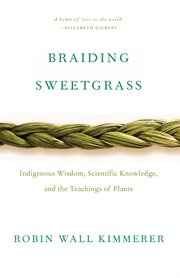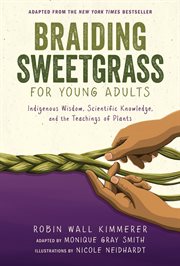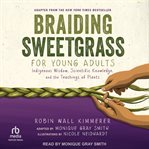Review by Choice Review
As she did with her John Burroughs Medal-winning Gathering Moss (CH, Nov'03, 41-1549), Kimmerer (SUNY-ESF) brings to this volume her expertise as a botanist, insights developed as mother and a member of the Citizen Potawatomi Nation, and beautiful writing. As the title suggests, she braids together diverse threads of experience and knowledge to create a unified vision of humans interacting with other "people"--animals, insects, plants--in "regenerative reciprocity." Kimmerer's environmentalism is grounded in science, including a graduate study confirming traditional knowledge that carefully harvesting sweet grass for basketmaking helps the plants grow. Most of the book's anecdotes and observations are centered in the countryside near Syracuse where the author lives. She explains eutrophication, through which a pond becomes a marsh becomes a meadow becomes a forest, and her efforts to reverse the process to provide a swimming pond for her daughters. She describes late-night excursions to carry salamanders across a dangerous road, pondering questions about long- and short-term aid. Braiding in stories from the Onandaga people and close studies of human and plant communities, Kimmerer skillfully demonstrates the urgency for and the benefits of ecological restoration. Summing Up: Highly recommended. All readership levels. C. A. Bily Macomb Community College
Copyright American Library Association, used with permission.
Review by Publisher's Weekly Review
With deep compassion and graceful prose, botanist and professor of plant ecology Kimmerer (Gathering Moss) encourages readers to consider the ways that our lives and language weave through the natural world. A mesmerizing storyteller, she shares legends from her Potawatomi ancestors to illustrate the culture of gratitude in which we all should live. In such a culture, "Everyone knows that gifts will follow the circle of reciprocity and flow back to you again... The grass in the ring is trodden down in a path from gratitude to reciprocity. We dance in a circle, not in a line." Kimmerer recalls the ways that pecans became a symbol of abundance for her ancestors: "Feeding guests [pecans] around the big table recalls the trees' welcome to our ancestors when they were lonesome and tired and so far from home." She reminds readers that "we are showered every day with gifts, but they are not meant for us to keep... Our work and our joy is to pass along the gift and to trust that what we put into the universe will always come back." (Oct.) (c) Copyright PWxyz, LLC. All rights reserved.
(c) Copyright PWxyz, LLC. All rights reserved
Review by Library Journal Review
Kimmerer (environmental & forest biology, State Univ. of New York Coll. of Environmental Science & Forestry, Syracuse) was awarded the 2005 John Burroughs Medal for outstanding nature writing for her first book, Gathering Moss. In these beautifully written essays, she explores the natural world, wedding the scientific method with the traditional knowledge of indigenous people. Kimmerer herself is a member of the Citizen Potawatomi Nation. Bringing together memoir, history, and science, she examines the botanical world, from pecans to sweetgrass to lichens to the three sisters (corn, beans, and squash), also describing moments of her past, such as boiling down maple sap to make syrup with her children. She shares her efforts to reclaim her culture through studying the language and learning to weave baskets. Intertwined throughout is the history of the injustices perpetrated against indigenous people and the land. Kimmerer writes of investigating the natural world with her students and her efforts to protect and restore plants, animals, and land. A trained scientist who never loses sight of her Native heritage, she speaks of approaching nature with gratitude and giving back in return for what we receive. VERDICT Anyone who enjoys reading about natural history, botany, protecting nature, or Native American culture will love this book.-Sue O'Brien, Downers Grove P.L., IL (c) Copyright 2013. Library Journals LLC, a wholly owned subsidiary of Media Source, Inc. No redistribution permitted.
(c) Copyright Library Journals LLC, a wholly owned subsidiary of Media Source, Inc. No redistribution permitted.
Review by Kirkus Book Review
Wisdom about the natural world delivered by an able writer who is both Indigenous and an academic scientist. "This braid is woven from three strands," writes Kimmerer, an enrolled member of the Citizen Potawatomi Nation: "indigenous ways of knowing, scientific knowledge, and the story of an Anishinabekwe scientist trying to bring them together in service to what matters most." The author's 2013 book of essays on Native folkways concerning plants and their roles in human life is reissued here with new illustrations and design, a handsome production that well serves her engaging text, which will be of interest to readers schooled in the work of writers such as Wendell Berry, Leslie Marmon Silko, and Joy Harjo. In Anishinaabe belief, writes Kimmerer, sweetgrass "was the very first to grow on the earth," a constant reminder of the creator called Skywoman. It holds a sacred role, and it represents an important component of what the author describes as "global ecosystems," which speak to the possibility of positive interactions between humans and the natural environment, a welcome optimism given all the counterexamples one might produce of our destructive influences. Rethinking that possibility requires going to first principles. As Kimmerer writes, the English word bay is a noun, trapping a natural thing into a static category best reserved for dead things, whereas the Ojibwe word wiikwegamaa, turning the concept into a verb meaning "to be a bay," "releases the water from bondage and lets it live." Indigenous knowledge instructs those who seek healthy relations with their surroundings in many ways. Kimmerer writes of a teacher who directs us to walk in such a way "that each step is a greeting to Mother Earth" while the dread monster called the Windigo speaks metaphorically to our need to consume: "The more a Windigo eats, the more ravenous it becomes." A smart, subtle overlay of different systems of thought that together teach us to be better citizens of Earth. Copyright (c) Kirkus Reviews, used with permission.
Copyright (c) Kirkus Reviews, used with permission.



